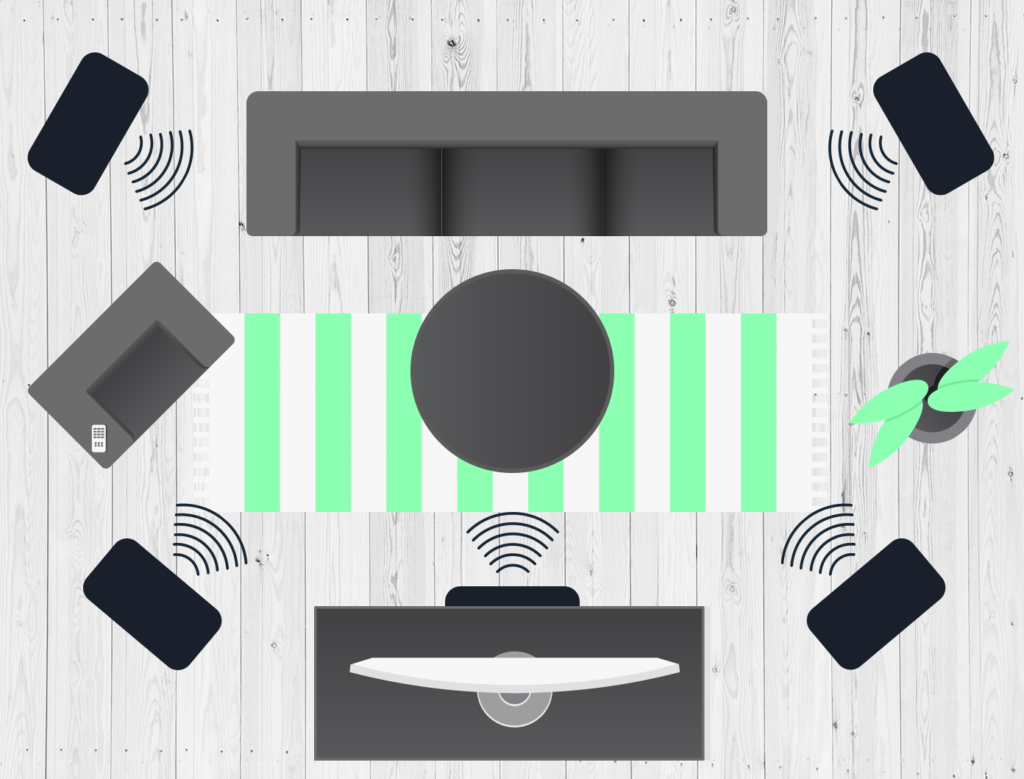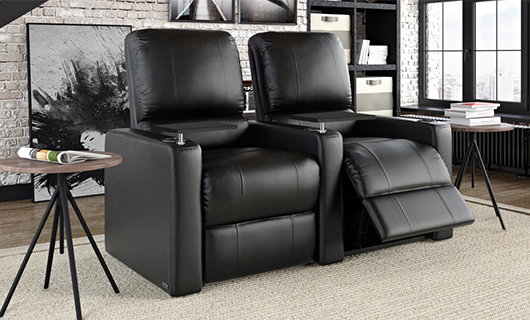Living in an apartment doesn’t necessarily mean you have to give up your dream of setting up a home theater. There will be some limitations especially in terms of space. For example, you won’t be able to get that 100-inch projector screen and a projector you have been drooling over. So there will have to be some compromises.
But setting up a home theater in small apartments isn’t impossible. In fact, it may even have some advantages. The sound system’s acoustics will be more impactful in a compact space and the setup cost will be lower. We have some suggestions that will guide you in your home theater setup – be it in your living room or a spare room.

Photo Credit: People photo created by freepik – www.freepik.com
Selecting the Right TV
While most people would want to install a projector, a TV is more suitable for small apartments. With a projector, you need to ensure that there is plenty of space between the screen and the projector. Otherwise, the video projected wouldn’t be able to cover the whole screen, which defeats the point of installing a projector.
TVs today come with technology that enables them to provide video with better quality than ever before. You have 4K technology that provides a crystal-clear picture with sharp colors.
When deciding what’s the right television for you, you need to make sure to pay attention to the following:
- What size would be perfect for the room?
- Do you need a Smart TV?
- Which technology is right for you?
When it comes to smaller apartments, we recommend you get a television that is between 50-60 inches. This ensures that the TV is not too big that it won’t fit or will give you spacing problems, but it is big enough for you to get a theater-like experience.
If you want the best quality of picture, we recommend opting for an Ultra HD television with 4K technology. Smart TV technology is highly recommended as it is revolutionizing how we watch movies and shows. You can easily stream movies and shows directly on your TV through Smart technology with the help of the internet.
Recommended TVs
Mounting the TV
Mounting a TV to the wall is a simple process, which can get complicated if not done properly. The first thing you need to do is decide what type of mount you want. There are several options – you can have a mount that keeps the TV static or one that allows you to move it around. For bigger TVs, the safe bet is to go with static mounts, which can be more stable.
You will need quite a few tools to mount the TV such as:
- Electric stud finder: to find a stud in the wall where the mount can be put.
- Drill: drill a hole in the wall where the mount will be screwed on.
- Screwdriver and screws: for screwing purposes.
- Spirit level: to ensure the mount is leveled before it is screwed on.
If you want to hide the wires – which we’d suggest so the setup looks nice and clean – then you will need a few more tools and tricks, depending on your house rules. If you are the owner, you could definitely just cut into the drywall and hide the wires that way. It requires more tools and it is pretty much permanent solution.
But, if you’re not looking for a permanent solution or you’re just renting an apartment, there are some DIY solutions to hide the ugly wires. You can fit plastic pipes that blend with the color of the wall, screw them on and have the wires run through them. This is a great way to hide the wire and not ruin the aesthetics of the room.
Picking a Video Player
Watching movies and TV shows has never been easier. Thanks to Smart TVs and the internet, you can stream video content directly to your TV with the help of video streaming applications.
There are numerous applications to choose from and the following are the more popular ones:
- YouTube
- Netflix
- Amazon Prime Video
- Hulu
- Vevo
To use these, all you have to do is download them to your TV. For Netflix, Amazon Prime Video, and Hulu there is a monthly or annual payment option. Once subscribed, you will have access to all the content in their media library. YouTube has free videos but has also launched YouTubeTV which has a cost associated with it.

Before you subscribe to any of the services, you can go through their media library to get an idea of which is more suitable. Amazon and Netflix have exclusive and original shows and movies along with the large library of TV shows and movies created by other big studios. You can definitely subscribe to more than one so you get access to more content.
Again, with the help of streaming applications, you won’t have to splurge on a Blu-ray player or have to set up a console to house the player, which saves you some space in the room and money in your budget.
A Smart TV isn’t the only way you can have access to these applications on your TV. Even if you opt for a TV without Smart technology, you can use a media stick, which is a USB that you can plug to the TV, or box. The technology will allow you to stream from various media applications to your TV. The most popular examples of these are:
- Google Chromecast
- Roku Streaming Stick
- Amazon Fire TV Stick
- Apple TV
You can find all applications that you would on a Smart TV on media stick and box. In fact, many of them even come with games you can play. Adding to your theater experience.

Setting Up the Sound
The sound is an important aspect for any movie experience. However, in an apartment, you want to make sure that the sound isn’t too loud that it disturbs the neighbors.
But before we get into tips on how to keep the audio from reaching your neighbors, it is important to decide on which speaker setup will give you the best acoustic experience.
For smaller apartments, there are two options for sound system setup either a 2.1 or 5.1 surround sound setup. A 7.1 channel system may be a bit too elaborate for a small room since it requires a bit more space.
The 2.1 channel setup would be for rooms in which you don’t really have space to set up speakers around you. The 5.1, which is a setup that is recommended, requires a little more space. In a 2.1 setup, there are two speakers with a subwoofer while in a 5.1 setup you have five speakers.
The placement of speakers is important in both setups. For 2.1, you have two front speakers one placed on the right of the TV and the other on the left.
For a 5.1 setup, you can play around a little but the recommended setup is:
- Front: left and right
- Side: left and right
- Back: center

The recommended setup is in relation to the seating. So two speakers in the front, one behind, and two to the side of the seats.
If you don’t have space to place the speakers on the floor then you can mount them on the wall. It will allow more floor space and less clutter in the room. Mounting speakers is less complicated than mounting a TV, since the speakers are much more compact. You will need the same tools as you would for mounting TV, but the process itself would be much simpler with speakers.
When placing the speakers on the ground, to reduce sound from traveling to the neighbors, you want to decouple the speakers. This means, rather than having them directly on the floor, you elevate them with a platform or a shelf so the sound vibration doesn’t easily transfer through the floor.
In the same manner, make sure the speakers aren’t placed too close to the walls so sound doesn’t travel through vibrations.
Recommended Compact Sound Systems
Saving Space with Compact Seating
Seating can be tricky if you want the theater experience. Generally, in theaters, you have spacious seats that take up some room. However, in your small apartment, you don’t have much space to work with, so you can’t go all out and get chaises and big recliners.
You can get comfortable seats that give the theater experience while not taking up as much space. The SeatUp Space Saver collection allows you to get theater-style recliners that are narrow yet comfortable. You also have the option of buying them in rows of up to 6 seats.
The number of seats you get obviously depends on the space in the room. Before ordering, make sure you check the dimensions and sizes of any seat you are considering. For example, the dimensions of a Bolt XS400 seat is roughly 33.5 X 39.5 X 44 inches. With 6 joined together the total area it occupies is 192.5 X 49 X 44 inches, which should easily fit in the living rooms of smaller apartments.
Recommended Seats
For optimum viewing pleasure, there is a science to seat placement. The seats should be a certain distance from the screen so viewers can get the best resolution. For a TV screen between 50-60 inches, you want to distance the seats at least 5.5 to 6 feet.
Another reason why screen bigger than that would be an issue for smaller apartment – you won’t usually have more than 6-7 feet to work with in terms of seat placement from the screen.
Accessories That Will Give You a Theater Experience
Popcorn is everyone’s favorite snack while enjoying a movie or their favorite TV show. However, popcorn in a packet doesn’t really give that movie theater experience. You need a popcorn maker that makes popcorns exactly like the theater. The West Bend 82505 is the perfect compact popcorn maker that makes popcorn like your favorite movie theater.
Carpet is an accessory within a room that enhances both audio and visuals of the room. It absorbs sound so it doesn’t reflect and distort. At the same time, carpeted floors ensure that the light from the TV doesn’t reflect from the floor causing visual displeasure. SeatUp has a carpet collection with prints that are perfect for home theaters. These can be fixed to the floor and wall.
These tricks and suggestions will have you well on your way to setting up an ideal home theater in your apartment. So now all you have to worry about is, who will you invite first to share the experience.







